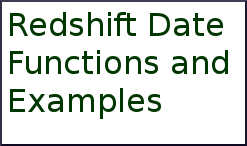


Redshift is a columnar database better suited for analytics, and thus a more appropriate platform for a data warehouse. Under the hood, PostgreSQL is a traditional row-oriented relational database, great for processing transactional data.If you're familiar with PostgreSQL features and syntax, how easy will it be to get used to Redshift?įirst, there are architectural differences between Redshift and PostgreSQL: PADB was itself based on PostgreSQL – so to some extent, Redshift is based on PostgreSQL – but "based on" leaves a lot of room for difference. In 2015 Amazon CTO Werner Vogels called Redshift "the fastest-growing service in AWS, ever." Meanwhile, ParAccel was acquired by Actian in 2013, and PADB was renamed Actian Matrix. While that deal might have seemed worthwhile for ParAccel at the time, it worked out even better for Amazon in the long run. PADB was notable because it was a columnar database that ran on commodity hardware, which made it a natural choice as a basis for a cloud-based analytic database platform.
Redshift data types numeric code#
Amazon invested $20 million in a company called ParAccel, and in return gained the license to use code from ParAccel Analytic Database (PADB) for Redshift. Amazon Redshift debuted in 2012 as the first cloud data warehouse, and remains the most popular one today.


 0 kommentar(er)
0 kommentar(er)
